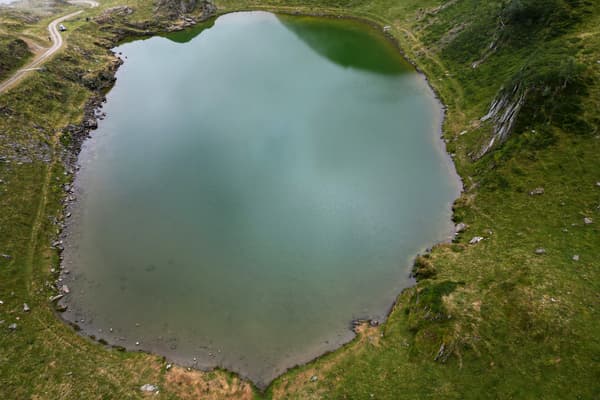An unusual color. This summer, the Areau pond, in Haut-Salat, Ariège, presented an unusual green color. A surprising phenomenon, but one that affects several high altitude lakes. According to some scientists, it is related to several factors, including the introduction of a small fish by fishermen.
A campaign to sound the alarm
Located more than 1,800 meters above sea level, the Cirque d’Etom lake, near the town of Cauterets, has acquired a surprising color in recent months, going from crystalline to green. The phenomenon has been observed in many mountain lakes in the Pyrenees.
The Pyrenees National Park and the Hautes-Pyrénées Departmental Fisheries Federation have raised the alarm through an advertising campaign “Let’s take care of the mountain lakes and streams,” he published in July, in which he expressed concern about this evolution.
“The remarkable diversity of species in these ecosystems can be undermined by the deterioration of water quality and also by the introduction of fish, predatory insects and amphibians,” laments the national park and the federation in a statement.

The introduction of fish.
In fact, scientists warn of the presence of marine species in high-altitude water bodies.
“When we see fish in mountain lakes, we see a disturbed ecosystem,” Adeline Loyau, a biologist and engineer at the National Polytechnic Institute of Toulouse, told AFP.
Fish was introduced to the mountains by man several centuries ago, first as a source of protein for shepherds and then, on a more massive scale, to supply hotels and restaurants in spa towns.
algae bloom
Among these fish, the biologist and her husband, a professor specialized in mountain ecology at the INP Dirk Schmeller, were especially interested in the minnow, a species less than ten centimeters long that normally lives in fresh rivers and is used as bait. alive.
When it manages to escape the hook or is released by fishermen, it acclimatizes well, devouring amphibians and insects, as well as zooplankton, “small microscopic crustaceans whose function is to eat fish”, algae and keeping the water very clear, very pure. “explains Adeline Loyau.
When a lake turns green, “it’s because the algae have won,” adds Dirk Schmeller.
“A cocktail of factors”
However, algae blooms are not solely due to minnows and the actual impact of this small fish on the ecosystem is at the center of lively debates among researchers.
For Didier Galop, research director at the National Center for Scientific Research (CNRS), a specialist in history and environmental geography, “there is a cocktail of disturbing factors” that can explain the greening of the lakes, such as the concentration of herds around they. hot spots or higher temperatures related to global warming.
For the scientist, also a fisherman, greening is a rather marginal phenomenon and is only one of the many symptoms of the deterioration of the water quality of mountain lakes. “There are also lakes that are very blue, but have zero biodiversity,” he emphasizes.
Dirk Schmeller and Adeline Loyau believe that green lakes are becoming more common, especially on small water surfaces. “We even have hikers who once came thirty years ago and who point it out to us,” says the researcher.
The question of “wild” reintroductions
On the other side of the Pyrenees, green lakes were observed in 2011 by Spanish researchers, who began fish elimination programs in 2014, using nets or electrofishing techniques.
In 2018, the Pyrenees National Park in France imitated them. But he discovered that the fish had subsequently been reintroduced “in the wild.” For this reason, it is committed to raising awareness among fishermen to find a balance between leisure and environmental preservation.
Sébastien Delmas, president of an association that brings together the federations of fishermen in the Pyrenees, recognizes that minnows represent a problem and wants to “harmonize the regulations”, which differ from one department to another, to limit live fishing in the mountains. But he believes other fish, like trout, have a perfect place there.
“Fish are also biodiversity: if they have been there for centuries it is because they are there,” he maintains.
Is tourism also involved?
According to him, we also have to look at tourism to understand the poor health of the lakes, because swimming with sunscreen or mosquito repellent products also has an effect on the ecosystem.
“On a summer day there may be three or four fishermen around a lake, but 300 swimmers. But we always blame the fishermen,” he laments.
Dirk Schmeller, a proponent of eliminating fish, also believes that the use of pollutants around lakes should be reduced. “Then we will only have to change global warming…” he points out ironically.
Source: BFM TV

